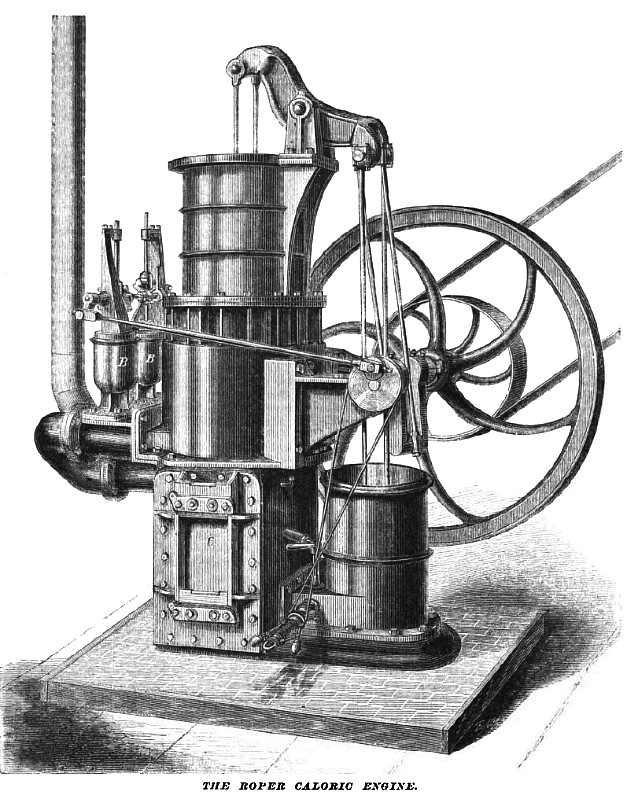|
Title: |
1871 Article-Sherrill Roper Air Engine Co., Caloric Engine |
|
Source: |
Manufacturer & Builder, V3, Aug 1871, pg. 185 |
|
Insert Date: |
2/21/2017 1:02:19 PM |
The Roper Caloric Engine
The use of heated air as a motor, and the invention of an engine which, shall be free from the many objections which have presented themselves, has for some time past formed the subject of the investigations of many of our most prominent engineers. Although the idea is not of a recent date, as patents have been granted on machines of this description as far back as 1810, still the inventor claims that none has overcome so many of the drawbacks which attend the construction and use of this engine as the one which forms the subject of this article. The Roper Caloric Engine, now manufactured by the Roper Caloric Engine Company, 124 Chambers Street, in this city, is constructed on an entirely new principle. Instead of heating the air in chambers or contrivances separate from the fire, and so permitting nine tenths of the heat to pass up the chimney, and thus be lost, as is the case with the engines heretofore introduced, it is forced directly into the furnace, thus coming in immediate contact with, the fire, by which a great degree of heat is instantly imparted, thus increasing the power ten or twelve-fold, with a corresponding economy of fuel. The expansive force of the gases generated by combustion is also thus availed of, giving still another large accession of power. This result is accomplished by the use of an air-pump, close air-tight doors to the furnace, and poppet-valves arranged as follows: The air, to supply oxygen for combustion, is pumped in by pump A; the carbon is burned rapidly and completely, under pressure, and the resulting carbonic acid gas and uncombined nitrogen gas from the air pass from the generator, or firebox, to the piston by the use of poppet-valves B, which act the same as steam marine-engine valves.
With this arrangement, a quiet, steady pressure is continued in the fire-chamber or air boiler, and the great difficulty experienced in others of a blast carrying ashes and too great a heat into the cylinder, and burning out packings, is fully obviated. The inside of the fire-box C is lined with heavy fire-brick throughout, and a wall of non-conducting material, three inches thick, between the brick and outer jacket, prevents injury to the iron.
One of the greatest improvements made, which places this engine in advance of others, is a perfect governor or regulator. The present regulator is placed back of the check, taking air from the pressure in the generator; and by use of a movable weight on the beam, the engine can be made to run from 40
to 120 revolutions per minute, as required, and that with a steady, smooth, unvarying motion, and nearly as noiseless as steam.
In addition to the advantages claimed, already enumerated, it possesses others of importance. It is economical in fuel, requiring for a one horse-power but 40 pounds of hard coal per day of ten hours; for a two-horse, 80 pounds; and for a four-horse, 120 pounds. It is absolutely free from all danger of explosion, and safer against fires than a common stove. Being perfectly safe, it is exempt from the extra rates of insurance charged by the companies on engines of this class. It is simple in its management. It works without much attention or oversight, and while in use the exhaust heat may be utilized to warm a building, or for other purposes, thus saving the cost of furnace fuel. It can be placed in any part of a building, and is eminently adapted to uses where small power is required.
In comparing this machine with the steam-engine, its favorable features are readily seen. It consumes less fuel, while the danger of boiler explosions with their attendant loss of life and property is totally obviated. There is no doubt, therefore, that in cases where a very great power is not required, these engines may be used advantageously in place of small steam-engines; and we have personally seen them in use for printing, grinding, hoisting, and divers mechanical operations, in which they appeared to give satisfaction. They should not be confounded with other caloric engines, as they differ essentially in construction, style, and mode of working. |
|
 1871 Sherrill Roper Air Engine Co., Caloric Engine
1871 Sherrill Roper Air Engine Co., Caloric Engine
|
|